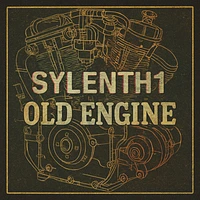-
 How to Make Your Synth Sound Like a Grumpy Old Car (Sylenth1 Tutorial)
How to Make Your Synth Sound Like a Grumpy Old Car (Sylenth1 Tutorial)Not the shiny, turbocharged ones that purr like kittens, but the kind that sound like they’ve been fed a steady diet of gravel and resentment. You know—the clattering, wheezing, “I-survived-the-90s” vibe of an old car engine. Recreating that in Sylenth1 isn’t just about twisting knobs; it’s about channeling mechanical angst. Buckle up.
Step 1: Start with Oscillator A1—The Cranky Foundation
Every engine needs a heartbeat, and ours begins with the Q-Pulse waveform in Oscillator A1. Set the octave to -2 and keep the voices at 1—this isn’t a choir, it’s a solo act with a smoking habit. The Q-Pulse gives you that raw, uneven throb, like a piston fighting for its life. Now, let’s talk envelopes. Crank the Attack to 0 because this engine starts immediately, no pleasantries. The decay sits at 0.2, a quick dip that mimics the sound of a engine reluctantly agreeing to run. Sustain stays maxed at 10—this car might be old, but it’s stubborn. Release is 0, because when you let go of the key, the noise stops dead, like someone yanked the battery cables.
Step 2: Shape the Filter—The Art of Controlled Chaos
Next, we’re slapping a band-pass filter on this bad boy. Set the cutoff to 3.9 and the resonance to 10, which adds a metallic screech, like a loose fan belt serenading a dumpster. Under Filter Control, nudge the Cutoff to 5.8 and dial the Resonance back to 0.5 to soften the scream into a grumble. The key track at 0.4 means higher notes sound slightly brighter, as if the engine is straining harder when you rev it—like climbing a hill in third gear with a trunk full of bricks.
Step 3: Modulation Envelopes—The Drama Queens
Time to introduce some mood swings. Modulation Envelope 1 starts with an attack of 0 because this engine doesn’t believe in slow starts. The decay of 2.8 lets the sound slump slightly, like a deflating air mattress, before hitting a sustain of 8.4—a wobbly middle ground where the engine pretends it’s fine. The release of 3.7 adds a dying sputter when you lift your finger, like the engine’s final gasp before silence.
Modulation Envelope 2 is simpler but equally dramatic. Attack stays at 0, because patience is overrated. The decay of 1.3 is a quick fade, like a driver slamming the brakes, while the sustain at 10 keeps the volume maxed out—no half-measures here. Release is 0, cutting the sound abruptly, as if the car just stalled in the middle of an intersection.
Step 4: LFOs—The Gremlins in the Machine
LFOs are where the magic (and the mechanical indigestion) happens. LFO 1 uses a saw wave at a 1/16T rate—a jittery, caffeine-fueled rhythm. Set the gain to 2.5 and assign it to pitch A-B at 2.7. This makes the pitch wobble like a misfiring spark plug, creating that “is-it-gonna-die?” tension.
LFO 2 also rocks a saw wave but slows things down with a 1/64T rate. A gain of 1.6 assigned to Volume A-B at 8.1 adds a slow, throbbing pulse to the volume, like the engine’s labored breathing. Drop the resonance to -6.8 to dull the edges, giving it that “buried under a tarp in a barn” texture.
Step 5: Effects—The Digital Junkyard
No vintage sound is complete without a layer of grime. Start with Bit-Crush Distortion set to 4.8 and 100% Dry/Wet. This isn’t subtle—it’s the sonic equivalent of duct tape on a cracked tailpipe. Then, slap on a chorus with 8.8 ms delay, 3.091 Hz frequency, and 40% depth. Keep the width at 100% and dry/wet at 45%. This chorus doesn’t sweeten the sound; it muddies it up, like exhaust fumes pooling in a garage.
Step 6: Play It Like You Mean It
Now, play. Hammer the lower keys for that rumbling idle, then climb up the keyboard to mimic revving. Don’t be too precise—real engines hiccup and stutter. Try uneven rhythms, like a driver pumping the gas pedal to keep the thing alive. Bonus points if you squint while doing it, as if you’re actually peering under a hood.
Final Step: Grab the Preset and Go
If all this knob-twisting feels like trying to fix a carburetor with a butter knife, I’ve got you covered. Download the ready-made preset here, and unlike an old car, it won’t leave you stranded.
There you have it: a synth patch that sounds less like a plugin and more like a midlife crisis on four wheels. Crank it up, and watch your DAW transform into a mechanic’s garage. (Optional: Add a screenshot of a rusty pickup truck to your project for maximum immersion.). Your fans will be so confused.)
